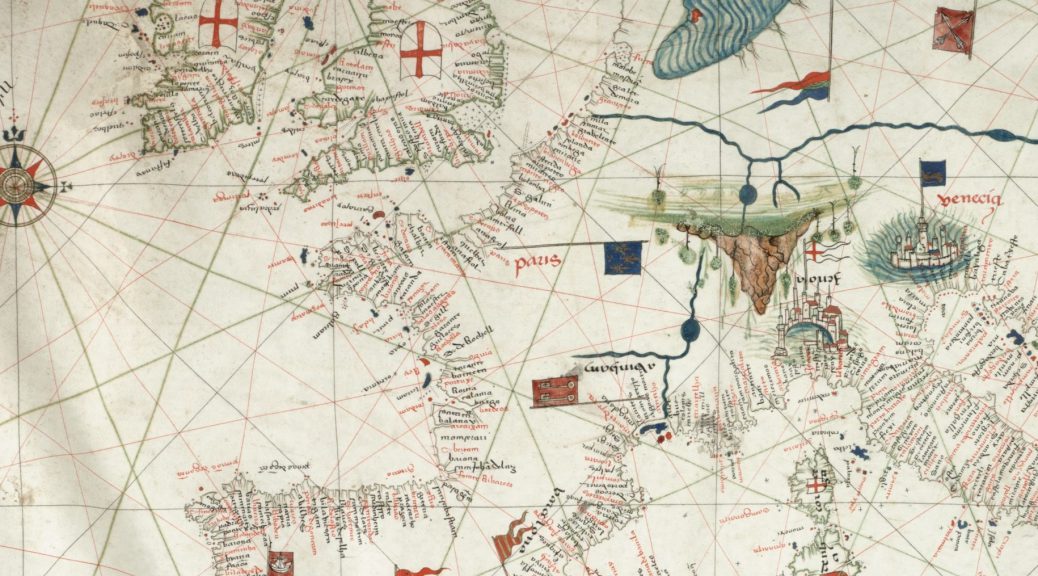Who knew the history of trying and testing for pregnancy would be so intertwined with maritime history? When I started my project, I never expected to be contemplating a visit to the National Maritime Museum archives in Greenwich, looking for ships, routes and cargoes. In my last post I talked about ships and now there are others coming up, too; it turns out I need to know a lot lot more about ships and sailors.
At the moment I’m thinking about the sixteenth century, exploring the story of Mary Tudor’s two false pregnancies (1554 and 1557). This has immersed me in texts and interests from the immediate aftermath of her death, and the reign of another childless Tudor queen, Elizabeth I. I have been looking at different writings from historians and poets, medical writers and others. Any historians of medicine reading this will know that health was intimately tied up with environmental factors in the medieval and Renaissance past and, not least, the wind. Wind was thought to blow through people connecting them up with the larger world, cosmos and elements.

Wind also had a special association with conception. Foetuses were thought to be ensouled at quickening through inspiration: they were literally breathed into life. Zephyrus, the west wind, from classical myth was thought to cause or contribute to the ripening of nature in the spring, at a historical moment when humans were not excepted from seasonal rhythms. You may know the opening to the Canterbury Tales which famously credits Zephyrus with pricking the spirits of little birds and simultaneously stirring longing for pilgrimage in people with all the opportunities pilgrimage offers for pleasure, for company, for reproduction of all kinds. Yet wind wasn’t only breath and life, it could also be flatulence and vacancy. Windy dropsy or windy tympany was the most common condition to be mistaken for pregnancy, because it swelled the stomach, just like in a pregnancy. Thinking about wind in relation to pregnancy enabled an agnosticism at a time when early pregnancy was often difficult to diagnose.

Entangled in the question of the wind and how responsible it was for royal reproductive disappointment and, by extension, England’s growing succession crisis, is an interest in the wind in relation to England’s maritime fortunes. To that end, I have recently been looking at the way that the winds are presented on maps, as individual personified beings at different points of the compass, drawn on maps as elaborate wind roses. ‘Winds’, writes Henry Peacham in The Gentlemans Exercise, ‘must be drawn with puffed and blowne cheekes,’ (rounded out but hollow shapes, like the abdomen distended by dropsy). In some ways there was less of a distinction than we might expect between wind roses and the representation of compasses. At a time when ships were sailing ships, winds were routes and, whilst land maps in the Middle Ages weren’t much used for getting around, sea charts or portolans certainly were.[1] Maps’ rhumb lines were the roads over which ships traveled and they lined up with the points of the compass, which also indicated the direction of different winds.

National Maritime Museum, London.
The wind was, of course, central to English maritime survival in the Anglo-Spanish wars of the late sixteenth centuries, which pitted Mary’s husband, Philip II of Spain, against Elizabeth, his one-time sister-in-law. Indeed, the Armada was defeated more by the wind than Elizabeth’s navy. Commemorative medals were made which celebrated this divine intervention in human affairs; ‘he blew’, the Latin caption read, citing the Biblical book of Job, ‘and they were scattered’. The Anglo-Spanish wars were also triangulated with America in an age of competitive colonial expansion, a project to which wind was, of course, absolutely crucial.


I’m finding that these winds out at sea were the same ones, and sometimes discussed in the same breath as those that were implicated in Mary’s false pregnancies, and perhaps Elizabeth’s childlessness, too. So now I am looking at some of the very famous paintings and keep seeing wind roses everywhere. There are certainly a lot of rounded out forms – the globe, etc. in this much-discussed Armada portrait; and what do you think of the designs in the background textiles here, particularly on the right? Can you see the billowy shapes around the fleur-de-lys points as stylized representations of puffs of wind?
Featured image: Portolan chart, Jorge de Aguiar (1492).
[1] See, for example, Alfred Hiatt, ‘From Hull to Cartage’: Maps, England and the Sea’, in Sebastian Sobecki ed., The Sea and Englishness in the Middle Ages (Brewer, 2011).



